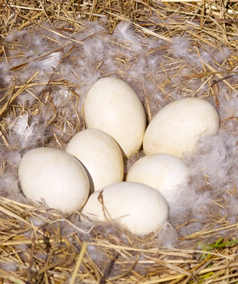
Geese are not particularly prolific layers, as poultry go. The top producers might lay about four dozen eggs per year, which gives goose eggs their high value.
The large white eggs are most often hatched to raise goslings for holiday roast goose. The eggs are also prized for creating craft items such as decorative goose egg jewelry boxes. Often overlooked is the fact that goose eggs are delicious to eat.
Most domestic geese start laying early in the spring of their first year. They hit their stride in their second year of life and peak at five, although a goose may continue laying for up to 10 years. How well a particular goose lays, and the length of her laying season, depends on the following factors:
- Breed
- Strain
- Age
- Diet
- Overall health
- Weather conditions
- Daylight hours
Geese tend to lay in the early morning hours, producing approximately one egg every other day. Providing nests for your geese to lay in helps keep the eggs clean and protects them from being cooked by sun, washed by rain, or frozen in cold weather. Plus eggs laid in nests are easier to find than eggs hidden under bushes or in tall grass.
A goose nest may be in the shape of a box, an A-frame, or a barrel on its side and braced to prevent rolling. A doghouse makes a nice goose nest. A good nest size for a goose is 24 inches wide and 24 inches high. The precise size is not critical, as long as the nest is:
- Tall enough for a goose to enter and sit comfortably
- Wide enough for her to turn around, since waterfowl don’t like to back up
- Small enough to offer a feeling of protective seclusion
- Separated physically or visually from the next nearest nest
- Situated in an area that is well protected from predators
- Open at only one end, so the goose can keep an eye on who might be coming
- Large enough to accommodate an abundance of soft nesting material.
A goose covers her eggs to hide them from predators. She will make her nest with items such as dry grass, leaves, twigs, and moss. She will then line it with her own feathers and down. Furnishing the nest you provide with a thick layer of dry leaves, shavings, or hay gives the goose materials to work with that will keep the eggs clean, reduce breakage, and prevent the eggs from rolling out of the nest. When a goose leaves the nest after laying an egg, she will pile nesting material on top of the egg to bury it, in an attempt to hide it from predators.
As laying season approaches, geese will start investigating available nesting sites. Ideally they will be enticed by the nice nests you provide. If not, you may have to embark on a goose egg hunt. In that case, use a china marker to identify these first eggs, and place them in the nest boxes. An egg already in a nest tells a goose it is a safe place to lay her next egg. Hopefully she will lay her future eggs in the nest, where you can easily distinguish the freshly laid eggs from the marked, older decoy eggs.
And that’s today’s news from the Cackle Coop.
Gail Damerow is the editor and principal author of Backyard Homestead Guide to Raising Farm Animals.

